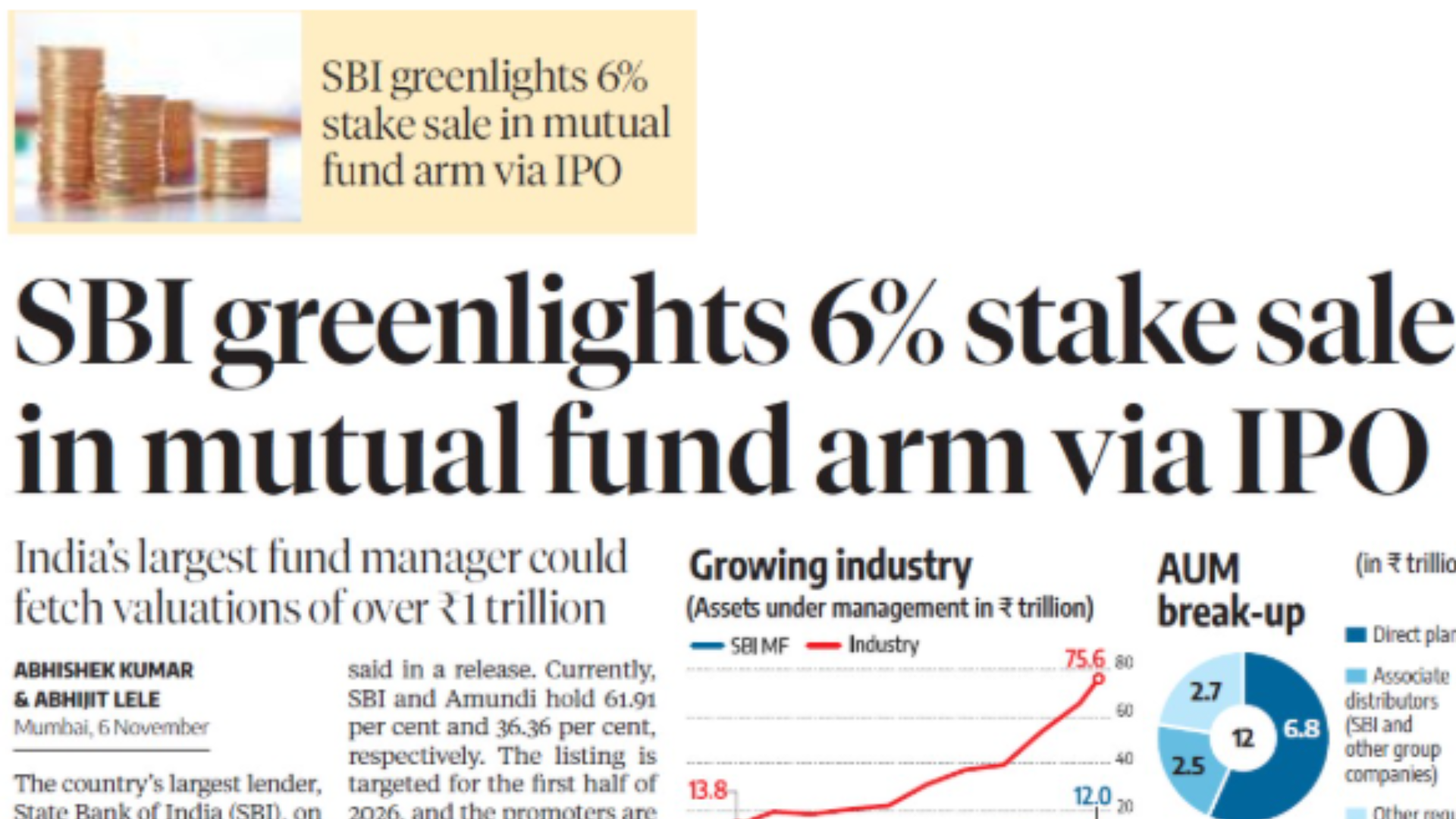SBI to List Its Mutual Fund Arm in 2026; IPO Could Value SBIFM at Over ₹1 Trillion
State Bank of India (SBI), the country’s largest lender, on Thursday announced plans to divest its stake in SBI Funds Management (SBIFM) through an initial public offering (IPO) in 2026, a move aimed at strengthening its capital position and supporting future credit growth.
The IPO will involve a 10% stake dilution, with SBI selling 6.3% and its joint venture partner Amundi’s India arm offloading 3.7%, subject to regulatory approvals.
Currently, SBI and Amundi hold 61.91% and 36.36%, respectively, in SBIFM.
According to senior SBI executives, the listing is targeted for the first half of 2026, and promoters are eyeing a valuation exceeding ₹1 trillion, with potential fundraising of ₹11,000–₹13,000 crore.
Capital Strengthening and Strategic Alignment
As of September 2025, SBI’s capital adequacy ratio stood at 14.62%, comfortably above the regulatory requirement of 12.30%, while its Common Equity Tier-I ratio was 11.47%.
Earlier in the July–September quarter, SBI raised ₹25,000 crore via a qualified institutional placement (QIP), further bolstering its balance sheet.
The upcoming IPO aligns with the finance ministry’s directive encouraging public-sector banks to monetise non-core assets.
Recently, Canara Bank’s mutual fund and insurance subsidiaries also accessed the capital markets through IPOs.
This marks the second time SBI has initiated SBIFM’s listing process — a similar plan in 2021 to sell a 6% stake was later shelved.
India’s Largest Fund House
SBI Funds Management oversees ₹28.3 trillion in total assets across its mutual fund and alternative investment divisions.
Its flagship arm, SBI Mutual Fund (SBI MF) — with an AUM of about ₹12 trillion — is India’s largest fund house, commanding a 16% share of the total mutual fund industry AUM.
Once listed, SBIFM will become the seventh asset management company (AMC) with mutual fund operations to be traded publicly, joining peers such as:
HDFC AMC, Nippon Life India AMC, Aditya Birla Sun Life AMC, UTI AMC, and Canara Robeco AMC.
ICICI Prudential AMC, which has secured regulatory approval for an IPO estimated at ₹10,000 crore, is also expected to list soon.
Valuation Benchmarks and Industry Context
Among listed peers, HDFC AMC leads with a market capitalisation of ₹1.2 trillion, followed by Nippon Life India AMC at ₹55,000 crore.
Websites tracking unlisted share trades currently value SBIFM at around ₹1.3 trillion, highlighting strong market appetite for the IPO.
“Considering SBIFM’s sustained strong performance and market leadership, it is an opportune time to launch the IPO process,” said C.S. Setty, Chairman, SBI.
“The listing will maximise value for stakeholders, create opportunities for investors, and enhance awareness of our products among a wider investor base.”
SBI’s Broader Listing Roadmap
SBIFM will be SBI’s third subsidiary to go public, following SBI Cards & Payment Services and SBI Life Insurance Company.
SBI General Insurance is likely next, with the bank aiming to position it among India’s top three general insurers.
The IPO pipeline reflects SBI’s effort to unlock value across its financial services ecosystem, supporting capital efficiency and strategic expansion across lending and investment businesses.
Industry Tailwinds: Mutual Fund Boom in India
The mutual fund industry continues to grow at a record pace, driven by retail participation and systematic investment plan (SIP) flows.
Monthly SIP inflows have risen to ₹30,000 crore, compared with around ₹8,000 crore before the pandemic.
The number of mutual fund houses has now exceeded 50, with eight new licenses issued in the past two years.
Foreign asset managers such as BlackRock (US), PAG (Hong Kong), and Sanlam (South Africa) have entered through joint ventures and strategic investments.
Future Outlook
Following reforms like GST rate rationalisation and capital market simplification, SBI has revised its FY26 credit growth target to 12–14%, up from 11%.
As of September 30, gross advances grew 12.73% YoY to ₹44.19 trillion.
SBI, like other major Indian banks, is preparing for the Expected Credit Loss (ECL) framework — a forward-looking provisioning model proposed by the Reserve Bank of India (RBI) to take effect from April 1, 2027.
The RBI has provided a four-year transition period for banks to absorb the higher provisioning impact.
For analytical insights on bank capital strategies, IPO valuations, and mutual fund market dynamics, explore views by Ranjit Jha (CEO) — a leading voice on investment banking and capital-market reforms.
To understand how financial-sector listings and AMC valuations influence long-term portfolio opportunities, connect with Rurash Financials — specialists in equity research, wealth strategy, and investment structuring.

